ALICE THROUGH THE LOOKING GLASS: 2 STARS. “fantasy grounded by dull story.”
“Alice Through The Looking Glass,” the six years in the making sequel to Tim Burton’s $1 billion grossing “Alice in Wonderland,” takes place in a world where butterflies speak and the Red Queen applies her lipstick in a heart-shaped motif, but what should be a flight of fancy is grounded by a dull story.
The topsy-turvy world of Underland is more or less intact since the last time Alice Kingsleigh (Mia Wasikowska) visited. Chess pieces still come to life, Tweedledee and Tweedledumb (Matt Lucas) continue to speak in rhyme and the Cheshire Cat’s (Stephen Fry) grin is as toothy as it ever was.
One thing is different, however. The Mad Hatter (Johnny Depp), Alice’s greatest friend and ally in the otherworld, is having some problems. Call him the Sad Hatter. “He’s just not the same anymore.” Thinking of his family’s demise courtesy of the fiery breath of the Jabberwocky has thrown him into a depression. To help the Mad Hatter out of his funk Alice steals a time travel device from Time (Sacha Baron Cohen) himself (“I am time,” he says, “the infinite, the immortal, the measurable… unless you have a clock.”) ignores warnings about changing the past and careens across the ocean of time to find out what happened to Hatter’s folks. “Do try not to break the past, present or future,” purrs the Cheshire Cat.
“Looking Glass” is an epic fantasy artfully directed by James Bobin but lacking the effortlessly odd feel of Tim Burton’s work on the first film. It’s a trippy story that transverses time and space and should invite the viewer to turn on, tune in and drop out but the true weirdness of the story, the unhinged voyages of imagination, are absent. Instead we’re thrown into a world that feels like we’ve seen it all before: familiar and not nearly whimsical enough. It’s a sea of CGI with a story cut adrift inside it.
It’s lovely to hear Alan Rickman’s voice, if only briefly, as Absolem the Caterpillar on screen again and Baron Cohen does his best to breath life into his character, but no one, not even the Mad Hatter—who should more rightly be called the Quirky Hatter—is interesting enough to merit the movie’s hour-and-forty minute running time. There is a high level of craft evident in the computer-generated images, the costumes and set decoration, everywhere, in fact, except the story that seems to value “time” puns over actual plot.
Perhaps in six years or so, if they decide to add another film to this franchise, they’ll take heed of a bit of “Looking Glass’s” theme about learning something from the past and give the next movie the excitement and story Lewis Carroll’s creation deserves.
